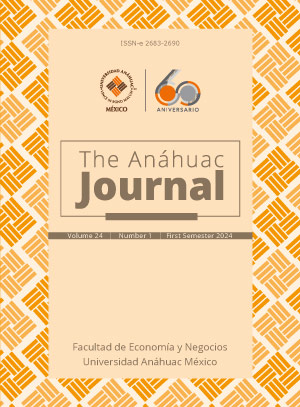Comparing the Performance of Long Short-Term Memory Architectures (LSTM) in Equity Price Forecasting: A Research on the Mexican Stock Market
Main Article Content
Abstract
This study compares the performance of univariate and multivariate Long Short-Term Memory (LSTM) to predict next-day closing prices on four stocks in the consumer retail sector of the Mexican Stock Exchange. Mean Absolute Error (MAE), Mean Absolute Percentage Error (MAPE), Median Absolute Percentage Error (MdAPE), and Root Mean Squared Error (RMSE) are used to test the networks’ performance. Results show a better performance on multivariate price forecasts when using 20-day and 15-day length sequences, generating consistent results for the sample, including illiquid and liquid stocks. On the other hand, univariate LSTM discloses lower forecast performance when predicting the price of illiquid stocks.
Downloads
Article Details
Section

This work is licensed under a Creative Commons Attribution-NonCommercial-ShareAlike 4.0 International License.
This work is licensed under a Creative Commons Atribución-NoComercial-CompartirIgual 4.0 Internacional.
How to Cite
References
Andi, H. (2021). An accurate bitcoin price prediction using logistic regression with LSTM machine learning model. Journal of Soft Computing Paradigm, 3(3), 205–217. https://doi.org/10.36548/jscp.2021.3.006 DOI: https://doi.org/10.36548/jscp.2021.3.006
Armitage, S., Brzeszczyński, J. & Serdyuk, A. (2014). Liquidity measures and cost of trading in an illiquid market. Journal of Emerging Market Finance, 13(2), 15–5196. https://doi.org/10.1177/0972652714541340 DOI: https://doi.org/10.1177/0972652714541340
Benchaji, I., Douzi, S. & Ouahidi, B. E. (2021a). Credit card fraud detection model based on lstm recurrent neural networks. Journal of Advances in Information Technology, 12(2), 113–118. https://doi.org/10.12720/jait.12.2.113-118 DOI: https://doi.org/10.12720/jait.12.2.113-118
Benchaji, I., Douzi, S., Ouahidi, B. E. & Jaafari, J. (2021b). Enhanced credit card fraud detection based on attention mechanism and lstm deep model. Journal of Big Data, 8(1), 1–21. https://doi.org/10.1186/s40537-021-00541-8 DOI: https://doi.org/10.1186/s40537-021-00541-8
Bhandari, H. N., Rimal, B., Pokhrel, N. R., Rimal, R., Dahal, K. R. & Khatri, R. K. (2022). Predicting stock market index using LSTM. Machine Learning with Applications, 9, article 100320. https://doi.org/10.1016/j.mlwa.2022.100320 DOI: https://doi.org/10.1016/j.mlwa.2022.100320
Ghosh, A., Bose, S., Maji, G., Debnath, N. & Sen, S. (2019). Stock Price Prediction Using LSTM on Indian Market Share. International Conference on Computer Applications in Industry and Engineering, 63, 101–110. https://doi.org/10.29007/qgcz DOI: https://doi.org/10.29007/qgcz
Haykin, S. (2010). Neural Networks and Learning Machines. Pearson Education India.
Krenker, A., Bešter, J. & Kos, A. (2011). Introduction to the Artificial Neural Networks. In K. Suzuki (Ed.), Artificial Neural Networks: Methodological Advances and Biomedical Applications. InTech. https://doi.org/10.5772/15751 DOI: https://doi.org/10.5772/15751
Landazuri Aguilera, Y. & Ruíz Pérez, R. (2021). El desempeño del sector productos de consumo frecuente en época de pandemia. Memorias del Coloquio Nacional de Investigación en las Ciencias Económicas y Administrativas, 114–132. https://shorturl.at/eEX78
Liebergen, B. V. (2017). Machine learning: a revolution in risk management and compliance? Journal of Financial Transformation, 45, 60–67. https://www.capco.com/Capco-Institute/Journal-45-Transformation
Lu, Y. (2017). Deep neural networks and fraud detection [Master’s thesis], Uppsala University. https://shorturl.at/ozEGI
Nielsen, M. (2015). Neural networks and deep learning. Determination Press, 25, 15–24. http://neuralnetworksanddeeplearning.com/
Nourbakhsh, Z., & Habibi, N. (2023). Combining LSTM and CNN methods and fundamental analysis for stock price trend prediction. Multimedia Tools and Applications, 82,17769–17799. https://doi.org/10.1007/s11042-022-13963-0 DOI: https://doi.org/10.1007/s11042-022-13963-0
Pramod, B. & Mallikarjuna, S. P. (2020). Stock Price Prediction Using LSTM. Test Engineering and Management, 83, 5246-5251. https://shorturl.at/bjtA2
Tianxiang, Y. & Zihan, W. (2020). Crude oil price prediction based on LSTM network and GM (1,1) model. Grey Systems: Theory and Application, 11(1), 80–94. https://doi.org/10.1108/GS-03-2020-0031 DOI: https://doi.org/10.1108/GS-03-2020-0031
Tirozzi, B., Puca, S., Pittalis, S., Bruschi, A., Morucci, S., Ferraro, E. & Corsini, S. (2007). Neural networks and sea time series: reconstruction and extreme-event analysis. Springer Science & Business Media. https://doi.org/10.1007/0-8176-4459-8 DOI: https://doi.org/10.1007/0-8176-4459-8
Wiese, B. & Omlin, C. (2009). Credit card transactions, fraud detection, and machine learning: Modelling time with LSTM recurrent neural networks. In Bianchini, M., Maggini, M., Scarselli, F. & Jain, L.C. (Eds.), Innovations in neural information paradigms and applications. Springer, 231-238. https://doi.org/10.1007/978-3-642-04003-0_10 DOI: https://doi.org/10.1007/978-3-642-04003-0_10
Yu, Y., X. S., Hu, C. & Zhang, J. (2019). A review of recurrent neural networks: Lstm cells and network architectures. Neural Computation, 31(7),1235–1270. https://doi.org/10.1162/neco_a_01199 DOI: https://doi.org/10.1162/neco_a_01199
Zaheer, S., Anjum, N., Hussain, S., Algarni, A., Iqbal, J., Bourouis, S. & Ullah, S. (2023). Multi Parameter Forecasting for Stock Time Series Data Using LSTM and Deep Learning Model. Mathematics, 11(3), 590. https://doi.org/10.3390/math11030590 DOI: https://doi.org/10.3390/math11030590

